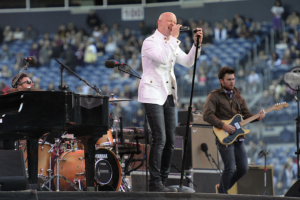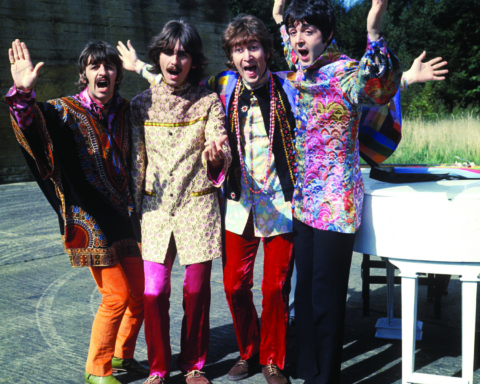Denver’s hometown heroes open up to DHM on the long journey from local bar band to international rock stardom
By Dave Muscari
The Rocky Mountains are a musical melting pot. Legendary bandleaders Paul Whiteman, Glenn Miller and Jimmie Lunceford attended Colorado high schools. Philip Bailey and Larry Dunn of Earth, Wind & Fire, and fiery jazz guitarist Bill Frisell are all Denver natives. The state is also home to a variety of influential contemporary performers including India.Arie, Big Head Todd & the Monsters and progressive bluegrassers The String Cheese Incident.
These days, however, Denver bands don’t come much bigger than The Fray. Formed in 2002 by classmates Isaac
Slade and Joe King while attending Denver-area schools, the Colorado band with a worldwide following has a story all its own. From local band climbing a steep ladder of success to international popstars with
a boatload of record sales, Grammy nominations and Billboard Music Awards in tow, The Fray has already chiseled their names into rock history.
The band laid the foundation for success right in their own backyard — a lot of gigs around Boulder and Denver playing to enthusiastic local fans like Claire Portwood Lumsden. She is an Internet sales representative with a national company who grew up in Denver. Lumsden was there when the band took off. “My sophomore year at CSU, when they started to play The Fray on the radio, I remember they talked about them being ‘an up-and-coming local band,’ and trying to find them on the Internet.” The first time she saw The Fray perform was 2003 at one of KTCL’s famous Freeloader shows at Denver’s Gothic Theater. “My girlfriends and I drove down from Fort Collins to see them. We only knew maybe a couple of songs, and, of course, we sang and screamed along with the band.”

The Fray’s first major success story arrived in an odd fashion. Slade’s younger brother, Caleb was once the band’s bass player but left after a disagreement. “You’ll need to buy me a whiskey for that one,” Isaac Slade told us when we asked about the specifics. “Or three.” Ironically, the rift became the inspiration for the song, “Over My Head (Cable Car)” which appeared on The Fray’s 2005 album How to Save a Life. The song went on to become the fifth-most downloaded single of 2006. The album’s title track was inspired by Isaac’s work at a camp for troubled teenagers. As for Caleb, he’s now a solo artist with a career of his own and an album, Victory in Defeat, which is available on iTunes.
Since those early years, the band has toured almost nonstop and released three well-received albums. Now, with a slew of industry honors and a wide base of rabid fans, The Fray’s anthemesque, piano-driven sound has secured its place on the power pop landscape. Obvious comparisons to English groups including Keane, Radiohead and Coldplay have been made in the press. “There are certainly worse bands to be compared to. Like Coldplay…or Tiny Tim any day,” joked Slade. Some critics suggest that The Fray’s sound is probably more heavily influenced by bands such as U2 and The Wallflowers, however, for Slade’s money, he says, “Ray Charles, Bush, Third Eye Blind, Counting Crows. Always wished I could be Ray though.”
When Westword magazine tabbed The Fray as Denver’s “best new band” in 2004, they received more airplay on local rock radio stations with a demo version of “Over My Head.” Late that same year, the band signed a deal with Epic records, reportedly onstage at Denver’s historic Fox Theater.
Sam Hill, music director and midday radio personality at KALC-FM, known as Alice 105.9, said the radio station began playing The Fray’s music in 2005, starting “…with their first official single ‘Over My Head.’ We’ve played that particular Fray song the most out of any other Denver radio station.” In fact, says Hill, “Alice played every single that was released from How to Save a Life. Our listeners are huge fans of The Fray. Out of all the local acts we’ve played over the years, they’ve been received very favorably…definitely in the Top 5 of all time.”
When “How to Save a Life” shot to No. 3 on the charts, it soon tied for the seventh longest charting single of all time on the Hot 100 chart with Carlos Santana’s smash “Smooth” at 58 consecutive weeks. It also topped the adult Top 40 for 15 consecutive weeks and found enormous success on the international charts as well. It was a Top 5 record in Spain, Canada, Australia, Sweden, Italy and the United Kingdom.
Just as “Over My Head” was climbing the charts, ABC announced that the album’s title track would be a center point in a fall promotional campaign for the 2006 season premiere of the network’s breakaway hit, Grey’s Anatomy. The visibility was enormous and helped push the song’s popularity week after week, driving it to No. 3 from No. 51 by October on Billboard’s Hot 100.
The band’s third album, Scars & Stories, is currently getting plenty of airplay. Released last February, it debuted at No. 4 on Billboard’s Top 200. The album is a departure from the previous two releases. There is a new producer on-board in Grammy-winner Brenden O’Brien. Over his career, O’Brien has produced and played on records with luminaries such as Bob Dylan, Pearl Jam, Stone Temple Pilots and Bruce Springsteen. He brought an edgier, rock ’n’ roll texture to The Fray’s new recording. The title of the album comes from the idea that the band has earned battle scars in life, on the road and as a group and survived to tell the tales. The first singles released include “Heartbeat” and “Run For Your Life.”
The band’s most recent concert tour began early last April in New York City and ended in November after stops in Australia, Singapore, Dubai and Manila. During the summer leg of the tour, The Fray coheadlined a series of dates with Kelly Clarkson, with opening acts Carolina Liar and Scars on 45.
Band members remain committed to local fans and the Denver community in general. “The guys in the band have always been really great at taking care of their hometown radio stations,” says Hill. “They regularly do one-off appearances for their fans and our listeners.”
A good example of their involvement has been through an annual telethon in support of Children’s Hospital Colorado. “Alice has been raising money for Children’s Miracle Network for a decade, and we’ve managed to raise over $10 million with the help of local businesses and generous listeners,” explains Hill. “We’ve had wonderful support from The Fray in that they’ve joined us on-air for a couple of hospital broadcasts where they’ve gone so far as to donate VIP experiences for auction with the money going to Children’s Hospital. That’s just one example of how generous and kind those guys are.”
“You really do feel like they love being a part of the community,” she adds.
We checked in with Isaac Slade recently while the band was touring on the other side of the world in Muscat, the capital of Oman. We wanted to know how it all started and what’s next for one of Denver’s most-loved musical forces.
DHM: Isaac, you and Joe are local guys. How did your backgrounds prepare you for the music you are producing today?
Slade: Growing up in Denver gives you a different take on the entertainment industry. It keeps you grounded, makes it a little harder to float off into space. Musically, it gave us a real earthiness to what we do — I like to think that came from my cowboy grandpa, Claude Graves. He was a badass.
DHM: Were there local bands or performers you followed closely?
Slade: I hatched a scheme in college, a local cable-access music show that combed the various scenes around town for the latest and greatest. It was pretty legit. We had 23 interns. It took me all over the Denver/Boulder area and exposed me to a lot of amazing music and the amazing people behind it. I also got to do probably 60 interviews with local industry folks, radio, print, promoters…everyone. It had a huge impact on how I viewed the industry, seeing it from that side. And musically, I discovered this huge pressure everyone felt to just be a sports-bar cover band. Every local artist seemed to have to wrestle with that: easy money playing Lynyrd Skynyrd or the long hard road of [playing] your own material. Needless to say, all the best artists were just about broke. That was inspiring.
DHM: How to Save a Life — the album and title track were enormously successful. Did you know when the band was recording that the album had such potential?
Slade: When you make art for public consumption you have no idea how it’s going to be received. You can guess, you can hope, you can test market…but you really don’t know. So we’ve always subscribed to the “work-till-you-like-it-yourself” school of thought. Sometimes it does well, sometimes it doesn’t. We’ve had both.
DHM: How important has the Internet been to your band?
Slade: I remember when we first bought our domain name back in 2002, and I figured out how to see viewer country of origin. I stared at this user’s IP address in Madagascar. We scrubbed toilets for eight months to raise $1,700, recorded our EP, then boom, some kid off the coast of Africa is listening to it. That was a trip.
DHM: Talk about the rigors of touring: What are the best and worst parts of the process?
Slade: I’m not really going to say anything bad about the rigors of touring. Catch me at the end of an 11-week run in an airport hotel, 40 minutes outside of Houston, and I may answer differently.
DHM: Can you describe the feeling of standing onstage, performing in front of thousands of fans as they sing along with the band?
Slade: It’s cool in the States. It’s even cooler in a country that hardly speaks English. It’s one of the finest feelings I’ve ever had the pleasure of having.
DHM: You have traveled the world. Is there any downtime to see it beyond looking down from the stage?
Slade: I tried bartering this kid in the Gold Souk [large market in Dubai, U.A.E.]. I wanted this turban thing, and he was clearly over-charging. I played hardball, and he didn’t budge, even a little. So I paid it. The next day the Dubai DJ informed me live, on-air that I paid about four times too much. That was hard. I bet that damn kid was listening, too, just smiling and sipping on his U.A.E. coffee, happy as can be.
DHM: You and Joe have enjoyed a tremendous writing partnership: How does that process work?
Slade: We both have big piles of demos and lyrics, tossing them back and forth all the time. Sometimes I’ll get stuck on a song, nothing but a verse, and go snag one of his chorus melodies and throw some new chords on it to fit the vibe. It’s a little like that scene in Wall Street, guys shouting for melodies, verses — I need a lyric about loneliness! Loneliness? Anybody?
DHM: Has it been difficult to maintain a friendship as the band has grown and become increasingly successful?
Slade: Any friendship takes work if you’re honest with each other. It would be much easier to just keep it surface and hire other people to write for us all, but if you’re going to make things together, to create together, you’ve got to keep it on the level. So that’s been work, but work well worth it.
DHM: Where do you see The Fray five to ten years down the road?
Slade: Making record No. 8!






